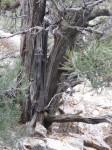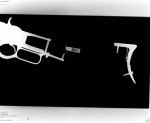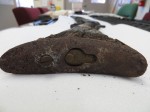 The cracked and weathered Winchester ’73 rifle found leaning against a Juniper tree in Nevada’s Great Basin National Park like its owner just stepped away for a moment 132 years ago and forgot to come back gets more mysterious the more it’s studied. The rifle was found in November of last year by park archaeologists and was sent to the Cody Firearms Museum in Cody, Wyoming, for conservation and additional research.
The cracked and weathered Winchester ’73 rifle found leaning against a Juniper tree in Nevada’s Great Basin National Park like its owner just stepped away for a moment 132 years ago and forgot to come back gets more mysterious the more it’s studied. The rifle was found in November of last year by park archaeologists and was sent to the Cody Firearms Museum in Cody, Wyoming, for conservation and additional research.
When the rifle arrived, the wood of the stock was chipping and a white salt encrusted it. Museum curators first stabilized the wood with a solution of adhesive, distilled water and ethanol and then sent the weapon to nearby West Park Hospital for non-invasive examination of its insides. At the hospital patient “Rifle” — literally, that’s the name on the file — was X-rayed and found to have an object  lodged in its butt stock, namely a cartridge stuck in the trap. To remove the cartridge, conservators lubricated the butt plate with penetrating oil* so it would loosen up enough that it could be unscrewed without damaging the splintered stock. The cartridge was taken out and identified as a Union Metallic Cartridge Company .44 WCF cartridge, manufactured between 1887 and 1911.
lodged in its butt stock, namely a cartridge stuck in the trap. To remove the cartridge, conservators lubricated the butt plate with penetrating oil* so it would loosen up enough that it could be unscrewed without damaging the splintered stock. The cartridge was taken out and identified as a Union Metallic Cartridge Company .44 WCF cartridge, manufactured between 1887 and 1911.
 The Winchester also had an unusual modification. The carrier block and carrier lever are missing. These parts are necessary for the rifle to fire repeatedly, so that means someone deliberately customized the a repeating rifle so that it could only fire a single shot. As a single shot rifle it could still be used for hunting, but it would be less than adequate for personal defense. What the advantage might be to the modification is unclear to me. It’s not like you have to fire back-to-back shots just because it’s a repeater. What’s to prevent hunters from firing one cartridge at a time, if that’s what they want?
The Winchester also had an unusual modification. The carrier block and carrier lever are missing. These parts are necessary for the rifle to fire repeatedly, so that means someone deliberately customized the a repeating rifle so that it could only fire a single shot. As a single shot rifle it could still be used for hunting, but it would be less than adequate for personal defense. What the advantage might be to the modification is unclear to me. It’s not like you have to fire back-to-back shots just because it’s a repeater. What’s to prevent hunters from firing one cartridge at a time, if that’s what they want?
 As far as identifying the owner or even any elements of the story behind the rifle’s century of Rip Van Winkling, that continues to be an enterprise with a very remote chance of success. When the Winchester was first discovered, Great Basin Cultural Resource Program Manager Eva Jensen found the serial number of the lever action repeating rifle listed in the Cody Firearms Museum’s archive of Winchester factory data, but the only information noted was its year of manufacture: 1882. The information of the cartridge shaves five early years off the possible date of the rifle’s abandonment.
As far as identifying the owner or even any elements of the story behind the rifle’s century of Rip Van Winkling, that continues to be an enterprise with a very remote chance of success. When the Winchester was first discovered, Great Basin Cultural Resource Program Manager Eva Jensen found the serial number of the lever action repeating rifle listed in the Cody Firearms Museum’s archive of Winchester factory data, but the only information noted was its year of manufacture: 1882. The information of the cartridge shaves five early years off the possible date of the rifle’s abandonment.
So far nothing else has been discovered to help narrow down the dates. Park archaeologists examined the find site for clues, maybe even human remains, and found nothing. Nor do area records help. Researchers perused fire records to see if there was one in the area. Since there is no evidence of fire damage to the Forgotten Winchester, if there had been fire in there then that the rifle could only have been left leaning against the tree significantly after the flames were doused. They found no recorded fire in the area. Cody Museum researchers are still studying the museum’s vast collection of Winchester company records to see if anything else might be buried in the files.
The Forgotten Winchester is currently drawing crowds at the Cody Firearms Museum where it is on display with another example of the same rifle in good condition so visitors can make a before and after weathering visual comparison. It will stay in Cody until this fall when it will return to Great Basin in time for the park’s 30th anniversary and the centennial of the National Park Service in 2016. After that it will remain on permanent display behind security glass at the Great Basin Park visitor’s center.
*